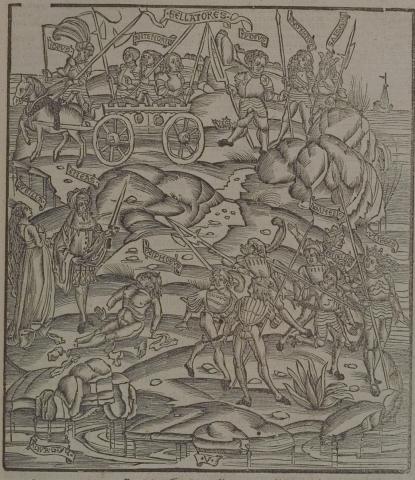Annotations
Aeneas and the Sibyl reach the Fields of the Warriors. At the top of the image, from right to left, Idaeus, Priam's charioteer (Page 489, note 485), drives his chariot (485); the three sons of Antenor ride in it (483-4). Tydeus, Parthenopaeus and Adrastus stand to their right (479-80). In the lower half of the image, to the right, Agamemnon and some of his warriors are shown running from Aeneas (489-93). Among these warriors, the two most famous members of his army, Ulysses and Menelaus, are present, even though their presence is not mentioned by Vergil and, strictly speaking, anachronistic. In front of Aeneas sits Deiphobus, the second Trojan husband of Helen, disfigured almost beyond recognition. He explains to Aeneas that Helen led Menelaus and his men directly to where he was sleeping and they killed him brutally (494-534). The river Styx flows through the very bottom of the image.
Woodcut illustration from the “Strasbourg Vergil,” edited by Sebastian Brant: Publii Virgilii Maronis Opera cum quinque vulgatis commentariis expolitissimisque figuris atque imaginibus nuper per Sebastianum Brant superadditis (Strasbourg: Johannis Grieninger, 1502), fol. 272r, executed by an anonymous engraver under the direction of Brant.


Sebastian Brant (1458-1521) was a humanist scholar of many competencies. Trained in classics and law at the University of Basel, Brant later lectured in jurisprudence there and practiced law in his native city of Strasbourg. While his satirical poem Das Narrenschiff won him considerable standing as a writer, his role in the transmission of Virgil to the Renaissance was at least as important. In 1502 he and Strasbourg printer Johannes Grüninger produced a major edition of Virgil’s works, along with Donatus’ Life and the commentaries of Servius, Landino, and Calderini, with more than two hundred woodcut illustrations. (Annabel Patterson)